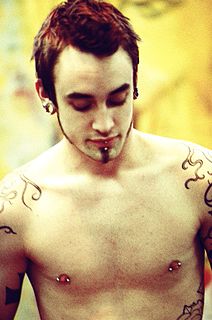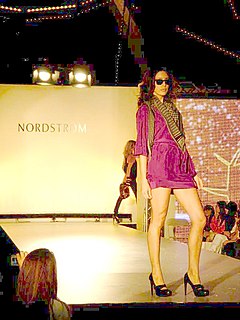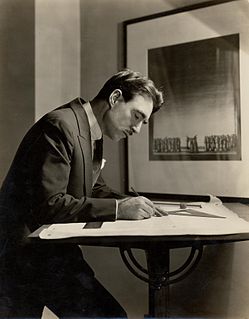 W
WBody piercing, which is a form of body modification, is the practice of puncturing or cutting a part of the human body, creating an opening in which jewelry may be worn, or where an implant could be inserted. The word piercing can refer to the act or practice of body piercing, or to an opening in the body created by this act or practice. It can also, by metonymy, refer to the resulting decoration, or to the decorative jewelry used. Piercing implants alter body and/or skin profile and appearance. Although the history of body piercing is obscured by popular misinformation and by a lack of scholarly reference, ample evidence exists to document that it has been practiced in various forms by multiple sexes since ancient times throughout the world.
 W
WIn the retail industry, a buyer is an individual who selects what items are stocked. Buyers usually work closely with designers and their designated sales representatives and attend trade fairs, wholesale showrooms and fashion shows to observe trends. They may work for large department stores, chain stores or smaller boutiques. For smaller independent stores, a buyer may participate in sales as well as promotion, whereas in a major fashion store there may be different levels of seniority such as trainee buyers, assistant buyers, senior buyers and buying managers, and buying directors. Decisions about what to stock can greatly affect fashion businesses.
 W
WA costume designer is a person who designs costumes for a film, stage production or television show. The role of the costume designer is to create the characters' outfits/costumes and balance the scenes with texture and colour, etc. The costume designer works alongside the director, scenic, lighting designer, sound designer, and other creative personnel. The costume designer may also collaborate with hair stylist, wig master, or makeup artist. In European theatre, the role is different, as the theatre designer usually designs both costume and scenic elements.
 W
WA dressmaker is a person who makes custom clothing for women, such as dresses, blouses, and evening gowns. A dressmaker is also called a mantua-maker (historically), modiste, or fabrician.
 W
WFashion design is the art of applying design, aesthetics, clothing construction and natural beauty to clothing and its accessories. It is influenced by cultural and social attitudes, and has varied over time and place.
 W
WFashion photography is a genre of photography which is devoted to displaying clothing and other fashion items. Fashion photography is most often conducted for advertisements or fashion magazines such as Vogue, Vanity Fair, or Elle. Fashion photography has developed its own aesthetic in which the clothes and fashions are enhanced by the presence of exotic locations or accessories.
 W
WA wardrobe stylist, also fashion stylist, is a consultant who selects the clothing for published editorial features, print or television advertising campaigns, music videos, concert performances, and any public appearances made by celebrities, models or other public figures. Stylists are often part of a larger creative team assembled by the client, collaborating with the fashion designer, photographer/director, hair stylist, and makeup artist to put together a particular look or theme for the specific project. A wardrobe stylist can also be referred to as a fashion stylist, fashion editor, or celebrity stylist. According to one view, "Stylists are the people who push each celebrity to make the best dressed list," and assist with editorial photo shoots.
 W
WA hairdresser is a person whose occupation is to cut or style hair in order to change or maintain a person's image. This is achieved using a combination of hair coloring, haircutting, and hair texturing techniques. Most hairdressers are professionally licensed as either a hairdresser, a barber or a cosmetologist.
 W
WThis is a list of notable hairdressers. "Hairdresser" is a term referring to anyone whose occupation is to cut or style hair in order to change or maintain a person's image. This is achieved using a combination of hair coloring, haircutting, and hair texturing techniques. Most hairdressers are professionally licensed as either a barber or a cosmetologist.
 W
WHat-making or millinery is the design, manufacture and sale of hats and headwear. A person engaged in this trade is called a milliner.
 W
WHat-making or millinery is the design, manufacture and sale of hats and headwear. A person engaged in this trade is called a milliner.
 W
WA make-up or makeup artist (MUA) is an artist whose medium is the human body, applying makeup and prosthetics on others for theatre, television, film, fashion, magazines and other similar productions including all aspects of the modeling industry. Awards given for this profession in the entertainment industry include the Academy Award for Best Makeup and Hairstyling, and entertainment industry awards such as the Emmy Awards, and the Golden Globes. In some countries professional licenses are required by agencies in order for them to hire the MUA. Bigger production companies have in-house makeup artists on their payroll although most MUA's generally are freelance and their times remain flexible depending on the projects.
 W
WMarchande de modes was a French Guild organisation for women fashion merchants or milliners, normally meaning ornaments for headdresses, hats and dresses, within the city of Paris, active from August 1776 until 1791. It played a dominating role within the commercial life and fashion industry of France during the last decades prior to the French Revolution. Amongst its members where Rose Bertin, Mademoiselle Alexandre and Madame Eloffe.
 W
WHat-making or millinery is the design, manufacture and sale of hats and headwear. A person engaged in this trade is called a milliner.
 W
WA perfumer is an expert on creating perfume compositions, sometimes referred to affectionately as a nose due to their fine sense of smell and skill in producing olfactory compositions. The perfumer is effectively an artist who is trained in depth on the concepts of fragrance aesthetics and who is capable of conveying abstract concepts and moods with compositions. At the most rudimentary level, a perfumer must have a keen knowledge of a large variety of fragrance ingredients and their smells, and be able to distinguish each one alone or in combination with others. They must also know how each reveals itself over time. The job of the perfumer is very similar to that of flavourists, who compose smells and flavourants for commercial food products.
 W
WA tailor is a person who makes, repairs, or alters clothing professionally, especially suits and men's clothing.
 W
WTextile geometry is the creative and technical process by which thread or yarn fibers are woven together or interlaced to form a flexible, functional, and decorative cloth or fabric which is subsequently printed upon or otherwise adorned. Textile design is further broken down into three major disciplines, printed textile design, woven textile design, and mixed media textile design, each of which utilize different methods to produce a surface ornamented fabric for variable uses and markets. Textile Design as a practice has evolved to become an industry integral to other disciplines such as fashion, interior design, and fine arts.
 W
WA wardrobe stylist, also fashion stylist, is a consultant who selects the clothing for published editorial features, print or television advertising campaigns, music videos, concert performances, and any public appearances made by celebrities, models or other public figures. Stylists are often part of a larger creative team assembled by the client, collaborating with the fashion designer, photographer/director, hair stylist, and makeup artist to put together a particular look or theme for the specific project. A wardrobe stylist can also be referred to as a fashion stylist, fashion editor, or celebrity stylist. According to one view, "Stylists are the people who push each celebrity to make the best dressed list," and assist with editorial photo shoots.